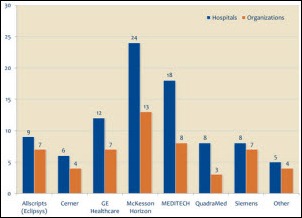Teens will certainly find a way to use their social media apps of choice. I'm not in favor of the…
News 7/29/11
Cerner’s Q2 numbers: revenue up 15%, EPS $0.42 vs. $0.33, beating earnings expectations by a penny after excluding one-time items.
Reader Comments
![]() From AzEMRGuy: “Re: Tucson Medical Center. Hiring for multiple Epic positions.” Above is the hospital’s recruitment video, which talks up Epic opportunities. I assume that means Allscripts Sunrise is egressing unless TMC switched systems since the last time I was there. CORRECTION: reader Zaphod Beeblebrox correctly notes that I confused University Medical Center in Tucson (a Sunrise client) with Tucson Medical Center. TMC is already an Epic customer.
From AzEMRGuy: “Re: Tucson Medical Center. Hiring for multiple Epic positions.” Above is the hospital’s recruitment video, which talks up Epic opportunities. I assume that means Allscripts Sunrise is egressing unless TMC switched systems since the last time I was there. CORRECTION: reader Zaphod Beeblebrox correctly notes that I confused University Medical Center in Tucson (a Sunrise client) with Tucson Medical Center. TMC is already an Epic customer.
![]() From Instamatic: “Re: displaced CIS vendors. This chart from the KLAS newsletter says 2010 sales volume remained about the same as 2009. Would you assume that most of the displacements are Epic’s?” I would assume so, especially given the win/loss numbers that KLAS put out along with the graphic (almost two-thirds of sales to 200+ bed hospitals went to Epic, with Horizon customers being especially ripe for the plucking). I’ve been saying for a year or two that Epic is dominating the market of mid-size hospitals and up (say, 300+ bed community hospitals, but also academic medical centers and IDNs), putting a big-time hurt on Cerner, non-Paragon McKesson, and the former Eclipsys. Not to mention as the healthcare system inevitably consolidates under healthcare reform, more organizations will hit Epic’s sweet spot of size and scope as they look to standardize. Vendors such as GE, QuadraMed, and Siemens weren’t much of a sales factor anyway, so that would seem to leave Epic on the high end and Meditech and Paragon for everyone else as the only vendors booking significant net-new customers. That’s not considering rural and critical access hospitals, which would look at Meditech, Paragon, HMS, Prognosis, and a few others. I think you’ll see the others trying to make their numbers with hosting, upselling, and services – in other words, they’re in a mature market, which can throw off some nice profits while waiting for the inevitable downward slide to accelerate. They all have other business lines, so they’ll be fine. I’m not saying that’s good or bad, just how it looks to me.
From Instamatic: “Re: displaced CIS vendors. This chart from the KLAS newsletter says 2010 sales volume remained about the same as 2009. Would you assume that most of the displacements are Epic’s?” I would assume so, especially given the win/loss numbers that KLAS put out along with the graphic (almost two-thirds of sales to 200+ bed hospitals went to Epic, with Horizon customers being especially ripe for the plucking). I’ve been saying for a year or two that Epic is dominating the market of mid-size hospitals and up (say, 300+ bed community hospitals, but also academic medical centers and IDNs), putting a big-time hurt on Cerner, non-Paragon McKesson, and the former Eclipsys. Not to mention as the healthcare system inevitably consolidates under healthcare reform, more organizations will hit Epic’s sweet spot of size and scope as they look to standardize. Vendors such as GE, QuadraMed, and Siemens weren’t much of a sales factor anyway, so that would seem to leave Epic on the high end and Meditech and Paragon for everyone else as the only vendors booking significant net-new customers. That’s not considering rural and critical access hospitals, which would look at Meditech, Paragon, HMS, Prognosis, and a few others. I think you’ll see the others trying to make their numbers with hosting, upselling, and services – in other words, they’re in a mature market, which can throw off some nice profits while waiting for the inevitable downward slide to accelerate. They all have other business lines, so they’ll be fine. I’m not saying that’s good or bad, just how it looks to me.
![]() From Mathemagician: “Re: Cerner. They can’t compete with Epic any more for hospitals of more than a couple of hundred beds, so they have three ways to drive growth: (a) sell to very small hospitals that don’t already have systems; (b) provide outsourcing services to existing customers, such as IT outsourcing and revenue cycle management; and (c) sell outside of the US where Epic doesn’t tread.” I would agree, adding also Cerner’s apparent interest (possibly Epic-motivated) in providing actual healthcare and healthcare management services rather than just IT products and services. Cerner’s biggest competitive weapon is its market cap, which provides options that the company appears to be tentatively exploring.
From Mathemagician: “Re: Cerner. They can’t compete with Epic any more for hospitals of more than a couple of hundred beds, so they have three ways to drive growth: (a) sell to very small hospitals that don’t already have systems; (b) provide outsourcing services to existing customers, such as IT outsourcing and revenue cycle management; and (c) sell outside of the US where Epic doesn’t tread.” I would agree, adding also Cerner’s apparent interest (possibly Epic-motivated) in providing actual healthcare and healthcare management services rather than just IT products and services. Cerner’s biggest competitive weapon is its market cap, which provides options that the company appears to be tentatively exploring.
![]() From rsm2800: “Re: Journal of Oncology Practice. The July issue contains 12 articles about EHRs in oncology.” Only subscribers can read the full text articles, but the titles relate to CCHIT certification; Memorial Sloan-Kettering’s chemo ordering system (which must be the amazingly cool Allscripts Sunrise work I saw at HIMSS last year); CPOE in peds oncology; standardized CPOE order sets; EMR-based checklists; use of natural language processing to extract clinical information from free text documentation; chemo medication administration systems; patient-physician e-mail; EMR effects on culture; CPOE outcomes; and the interest in sharing information by those with cancer. The topics sound excellent.
From rsm2800: “Re: Journal of Oncology Practice. The July issue contains 12 articles about EHRs in oncology.” Only subscribers can read the full text articles, but the titles relate to CCHIT certification; Memorial Sloan-Kettering’s chemo ordering system (which must be the amazingly cool Allscripts Sunrise work I saw at HIMSS last year); CPOE in peds oncology; standardized CPOE order sets; EMR-based checklists; use of natural language processing to extract clinical information from free text documentation; chemo medication administration systems; patient-physician e-mail; EMR effects on culture; CPOE outcomes; and the interest in sharing information by those with cancer. The topics sound excellent.
HIStalk Announcements and Requests
![]() Have you kept up with HIStalk Practice this week? A few highlights: MGMA joins CHIME and other professional organizations in calling for HHS to withdraw its proposed HIPAA accounting of disclosure rules. DrFirst intros an e-prescribing option for controlled substances. The American Academy of Ophthalmology publishes a list of EHR requirements for ophthalmologists seeking to achieve Meaningful Use incentives. Salaries for physician practice managers remained flat in 2010. Sign up for the e-mail updates while you are passing through and thanks for reading.
Have you kept up with HIStalk Practice this week? A few highlights: MGMA joins CHIME and other professional organizations in calling for HHS to withdraw its proposed HIPAA accounting of disclosure rules. DrFirst intros an e-prescribing option for controlled substances. The American Academy of Ophthalmology publishes a list of EHR requirements for ophthalmologists seeking to achieve Meaningful Use incentives. Salaries for physician practice managers remained flat in 2010. Sign up for the e-mail updates while you are passing through and thanks for reading.
![]() I featured Aventura in the latest Innovator Showcase this week. Just to recap the process: several dozen companies nominated themselves to be included; my expert team of investment bankers and providers chose eight of them after reviewing their application materials; and those companies will complete a video, a customer testimonial, and a telephone interview to be presented with their showcase article. Two of the eight have been featured so far. It’s quite a bit of work for the companies and for me, but readers have asked me repeatedly to give creative vendors a chance to be seen.
I featured Aventura in the latest Innovator Showcase this week. Just to recap the process: several dozen companies nominated themselves to be included; my expert team of investment bankers and providers chose eight of them after reviewing their application materials; and those companies will complete a video, a customer testimonial, and a telephone interview to be presented with their showcase article. Two of the eight have been featured so far. It’s quite a bit of work for the companies and for me, but readers have asked me repeatedly to give creative vendors a chance to be seen.
Keep an eye on the swinging pocket watch … you are getting sleepy … when you awaken, you will feel happy and rested. You will immediately sign up for e-mail updates to your upper right … your legs and arms are getting heavy … you will make the inevitable electronic connections offered by Facebook and LinkedIn to Inga, Dr. Jayne, and Mr. H … you can barely keep your eyes open …. you love HIStalk’s sponsors and will feel fulfilled by clicking their ads … going into a deeper sleep as you pledge to send me news, rumors, articles, or anything interesting … you’re become a little more alert … when I count three you will awaken rested and refreshed, feeling better than you’ve ever felt … one, two … and almost forgot, you’ll bark like a dog every time you hear the word “interoperability,” you’ll never embarrass yourself again by writing trite Internet phrases such as “wow, just wow” or “Best. Wine. Ever” and you’ll send love notes to Mr. H and Inga … three. Thanks to readers for reading, sponsors for … sponsing, and caregivers for caring.

McKesson reports Q1 results: revenue up 9%, EPS $1.13 vs. $1.10, meeting Wall Street revenue expectations but falling short on earnings. Technology Solutions revenue was up 6% with adjusted profit of $119 million. The earnings call transcript should be out tomorrow and it usually has some interesting nuggets about the company’s software business.
Private equity firm Blackstone Group is rumored to be in discussions to acquire Emdeon for more than $3 billion. Shares jumped from less than $13 to over $16 on Thursday, closing at $15.49.
Healthcare learning and employee competency platform vendor HealthStream announces Q2 results: revenue up 26%, EPS $0.08 vs. $0.06.
NextGen parent company Quality Systems, Inc. reports Q1 results: revenue up 21%, EPS $0.65 vs. $0.42, beating estimates on both. Shares will split two for one on October 27.
CPSI’s Q2 numbers: revenue up 30%, EPS $0.72 vs. $0.39, blowing through estimates.
Revenue cycle management company Precision Revenue Strategies renames itself MediRevv.
Medicity’s performance is featured in Aetna’s earnings call Wednesday, which said its contract backlog is $200 million. Aetna made $537 million in profit on $8.3 billion in revenue for the quarter. Also stated about Medicity, which it acquired on January 3 for $500 million:
Our strategy is to grow our footprint in this space and to deliver clinical and administrative content through Medicity’s installed base of health information exchanges. For example, Medicity has developed and is beginning to distribute a suite of applications that are certified as being compliant with the federal meaningful use standards. Medicity’s application development expertise and patented distribution technologies are great examples of how the company combines content and connectivity.
At Aetna, we are excited about our role in promoting health information technology because we believe it has tremendous potential to improve the quality of health care and to make health care more affordable. We continue to build a portfolio of businesses that simultaneously generate high growth fee revenues and improve the performance of our health plan businesses.
Sales
Texas Health Resources contracts with Streamline Health for its Epic Integration Suite.
The Tehachapi Valley Healthcare District Board of Directors (CA) approves the purchase of Healthland’s EHR. The local paper reports that the $400K five-year cost of HMS was one-fourth that of competitor McKesson.
HealthSouth selects Cerner to provide EHR for its 97 inpatient rehab facilities.
Memorial Hermann chooses CodeRyte for computer-assisted coding.
Hoag Memorial Hospital Presbyterian (CA) signs for Unibased ForSite 2020 Resource Management System for enterprise scheduling and a patient portal.
Former Wipro Technologies CIO Laxman K. Badiga joins Anthelio as COO.
Pat Cline, president and board member of Quality Systems, announces that he will retire this year.
Accretive Health names Joseph Bellini chief revenue officer.
Shared Health hires former WebMD founding COO Michael Heekin as CEO.
Announcements and Implementations
Misys Open Source Solutions wins the international “Best Use of Open Source Technology” award for its Misys Connect HIE solution.
The Rhode Island REC accepts ABILITY Network as an health information service provider to provide its member secure health information exchange.
Epocrates announces first phase availability of its Epocrates EHR mobile and Web-based EHR, designed for primary care practices with 10 or fewer physicians. The company will also offer a license to a native Apple iPhone app that supports remote patient look-up, schedule access, and e-prescribing capabilities.
Other
CMS’ Office of the Actuary predicts that national healthcare spending will hit $4.6 trillion by 2020, up from this year’s $2.7 trillion. The biggest increase in spending (8.3%) will occur in 2014, when many federal health reforms take effect.
![]() The Salt Lake City paper observes the challenges of connecting physician practices and hospitals via Utah’s Clinical Health Information Exchange, with incompatible EMRs leading the list. An interesting tidbit that may have been inadvertently disclosed by a University of Utah Health Care spokesperson: they’re using Cerner on the inpatient side and Epic for outpatient, but will soon migrate to a single system. You’ll want big odds if you’re betting on Cerner to win that deal.
The Salt Lake City paper observes the challenges of connecting physician practices and hospitals via Utah’s Clinical Health Information Exchange, with incompatible EMRs leading the list. An interesting tidbit that may have been inadvertently disclosed by a University of Utah Health Care spokesperson: they’re using Cerner on the inpatient side and Epic for outpatient, but will soon migrate to a single system. You’ll want big odds if you’re betting on Cerner to win that deal.
The Town of Freetown (MA) lays out the requirements Meditech will need to meet to develop a five-story, 186,000 square foot office building there that could bring up to 800 jobs to the area. Meditech’s costs are estimated at $80-100 million.
![]() Tampa General Hospital (FL) files a $9.2 million claim against the estate of a deceased 29-year-old patient who had spent five years as an inpatient. Maybe they should use any proceeds to hire case managers or buy equity in a skilled nursing facility that will accept transfers.
Tampa General Hospital (FL) files a $9.2 million claim against the estate of a deceased 29-year-old patient who had spent five years as an inpatient. Maybe they should use any proceeds to hire case managers or buy equity in a skilled nursing facility that will accept transfers.
Sponsor Updates
- Cottage Hospital (NH) achieves Medicare Stage 1 Meaningful Use through its use of the Healthcare Management Systems (HMS) EHR.
- Michigan Eye Institute chooses the SRS EHR for its eight-provider, five-location practice.
- Five providers from Aquidneck Medical Associates (RI) receive an $18,000 check for their Meaningful Use of the eClinicalWorks EHR, making them among the first in the state.
- Microsoft recognizes MEDSEEK as its 2011 US Public Sector Partner of the Year.
- Milwaukee Health Care Partnership and Wisconsin Health Information Exchange (WHIE announce a two-year extension of their contract with My Health Direct.
- St. Mary’s Regional Medical Center (OK) selects Merge Healthcare’s cardiology solution, while Sisters of Mercy (MO) adds the company’s iConnect solution.
- Mount Carmel Health Partners (OH) chooses MedVentive Population Manager to support improved patient care and clinical outcomes.
- Lexmark reports record earnings for Q2 and acknowledges the contribution of its Perceptive Software business unit.
- Health Language Inc (HLI) launches an upgrade to its Provider Friendly Terminology solution, now containing over 120,000 terms.
- T-System announces a call for entries for its Client Excellence Awards.
- Sentry Data Systems expands to a new office in Austin, TX while partnering with UT’s health IT program.
- GetWellNetwork adds two options for its interactive patient care system, a multi-function touchscreen and a lower-price, eco-friendly nettop.
- ZirMed announces successful transmission of claims and receipt of electronic remittance advices using HIPAA 5010 format.
EPtalk by Dr. Jayne
Quite a few organizations are using scribes as part of their EHR. A local hospital (which happens to be an Epic client) recently started using scribes in the emergency department, with the goal of having scribe coverage for all emergency physicians by early next year. According to a PR piece, several companies provide scribes and offer scribe training, with an estimated 200-plus hospital emergency departments starting to use scribes over the last two years.
Our group experimented with scribes several years ago when there weren’t as many formal opportunities for scribe training. We mainly wanted to use scribes in physician offices to aid EHR adoption and provide a safety net for older docs who were close to retirement and resistant to EHR implementation, but who still needed to get data into the system for patient safety and care continuity purposes.
A medical assistant or medical secretary would typically receive additional training, but it was rare for the practice to go the distance and hire someone to do the staffer’s usual work while he/she was scribing. As you can imagine, it doesn’t go well when you take a full-time employee and add another full time job to his/her plate. The program was dead before it ever left the gate.
Scribe staffing firms target pre-medical and pre-nursing students who are looking for experience in the healthcare field who are willing to work cheap. Starting salary for a scribe is $8 to $10 an hour. After preclinical training, the firm that’s staffing our local hospital includes a 100-hour “apprenticeship” with a senior scribe before new scribes are allowed to work independently.
The non-profit American College of Clinical Information Managers (ACCIM) recently emerged to hopefully help the rapidly proliferating scribe programs develop standards and monitor themselves. A visit to their website revealed an online training program and an exam leading to certification as a Clinical Information Manager, which can be taken after as little as 100 hours of work with a minimum of 100 patients documented. The exam costs $40 and an annual certification costs $20.
I like the idea that they require certified scribes to complete 20 hours of continuing education a year. Our state medical board only requires 25 hours for physicians and I think that’s pretty sad. Although the website said it would have a list of individual certified scribes, I wasn’t able to find it. Corporate members of the ACCIM include Scribe America and Emergency Medicine Scribe Systems.
As a physician, I’d love to know that all my data is being captured the way I like it while I can focus on the patient in front of me. From experience, though, I know it’s hard to have that level of teamwork and trust when you’re in a shift-work environment. I’ve done my share of emergency department work, and unless the scribes are remarkably consistent, I think it would be hard to have a different one for every shift.
The local paper profiled this change, noting that the scribes “win” by seeing jobs first-hand as they are “attached to the hip of a physician.” Do they really? I wonder what the average shelf life of a scribe is?
Depending on what they see, it might send them running in the opposite direction of actually entering the healthcare field. Most pre-med students are pretty smart cookies who will quickly figure out if they truly have a calling for days where you stand for 12 hours without a meal or a trip to the bathroom in exchange for taking on upwards of $250,000 in student loan debt.
On the other hand, it’s a great way to get experience and actually get paid. Back in the dark ages when I was an undergrad, unless your parent was a doctor and would hire you to work in the office, the only experience you could get was as a volunteer. I’d certainly rather have had the opportunity to do scribe work than to do what I did, which was to edit a medical textbook written by an extremely cranky researcher who had chosen someone without a firm grasp of the English language to do a first pass on her book before firing him. Although frustrating, I must say it prepared me for some of the technical manuals and white papers that grace the ever-growing stacks on this CMIO’s desk.
Do you have scribes at your hospital or health system? Do they make for happier EHR users? E-mail me.

Contacts
Mr. H, Inga, Dr. Jayne, Dr. Gregg.



















Re: Cerner – I do believe there are three more strategic variants for them to somewhat add to your three:
4) Improve the hospital-billing revenue cycle product and supporting applications and technologies like their medication cabinets and existing modules (ex: Business Intelligence, Cardiology, Surgery, ICU, ED) while adding pharmacy robotics, packaging stations, oncology, anesthesia, buy-out/license Smart Room technology from UPMC, and most critically – add a registry. This would provide the capability to sell to even more hospital-focused delivery systems of any size. If they coupled this with one partner for Health Information Exchange and a handful of partners for private practice physician systems in addition to the old VitalWorks that they acquired, I think they’d have a good story to tell. It would be one of integration, SaaS with the outsourcing, preparing for pay for performance and risk arrangements with a registry enabled by some HIE (only a hospital and Cerner would have the data experts to handle the constant mapping challenges), and working with private practice physicians where they do not have to join big brother like Epic clients do.
5) Do almost all the above and buy and integrate a better practice management and ambulatory EHR. In this case, forget the partners for private practice solutions but leave-in the HIE. This would be a me too strategy like Allscripts but VitalWorks is a dog.
6) Break-out the lobbying power and start hitting the Legislature hard to enable building of a research and benchmarking database from all information from a select set of Cerner customers. Cerner would need to build a consistent base system with common data definitions and maintain this through a strong architecture group coupled with excellent analytics resources. All of this would come through outsourcing with some dedicated resources to each facility choosing the buy the model They should gain some discounts, access to dedicated resources from Cerner, be remote hosted (RHO) for application and technical support and Cerner should throw-in handling a common set of reporting headaches (ex: PQRI, Meaningful Use, CMS) for ‘free’. This could easily be copied so the semblance of a competitive advantage would come from their common data architecture, human resources and easing requirements for their customer. The challenge would be fending-off similar lobbying from other vendors and it turning into an open source research database fantasy.
Regardless, Cerner needs to build better rapid cycle conversion and merger and acquisition expertise. Not the M&A experience to run the entire deal but to handle their portion of it without losing their services lunch to other consultants.
Re: Scribes
My daughter has been working as a scribe for almost a year now and she loves what she is doing. After training, the new scribe goes into a pool where they are assigned randomly to the physicians. When a physician finds a scribe they work well with, the physician can request permanent assignment with that scribe. At that point the scribe is assigned to the same schedule as the physician.
At this time my daughter works primarily for one physician and has learned his needs and how to make his job easier. In return he has been a mentor to her guiding her not only in her job but what to do in the future to prepare her for school and enhance her career.
It appears to be a win-win situation for both the physician and the scribe.
So to summarize Cerner’s options are: 1) compete with Epic; 2) compete with McKesson, Siemens, Optum, and GE; 3) compete with Allscripts; 4) compete with Premier – and every other company trying to move into the business intelligence space. Cerner will get stomped in spaces 2 and 4 and have a lot of ground to make up in space 3. Best to stick with what they do best- EMRs- and just do it better to try to compete with Epic where at least they have a chance. Or just sell to Unitedhealth and be done with it.
did anyone actually read Cerner’s earnings?